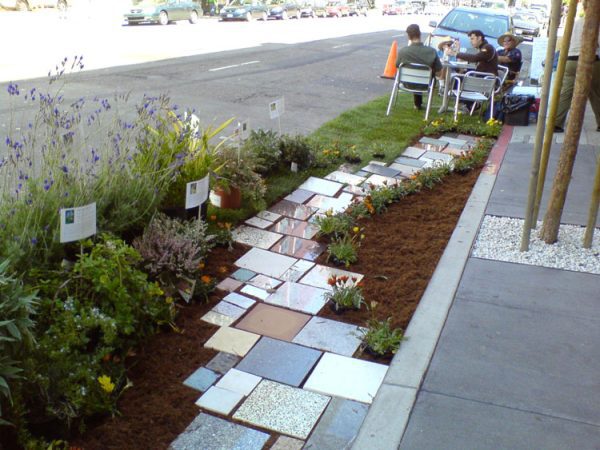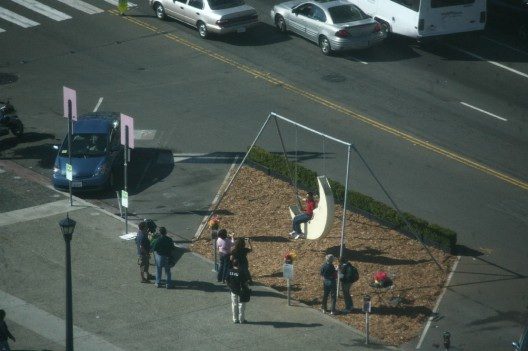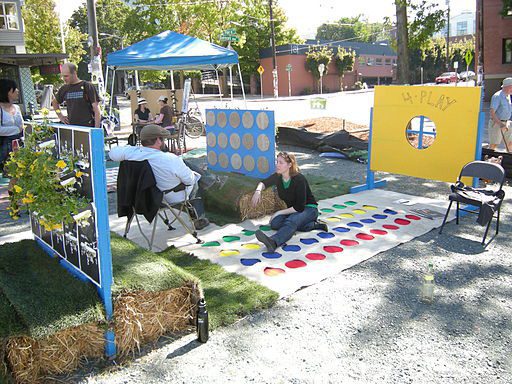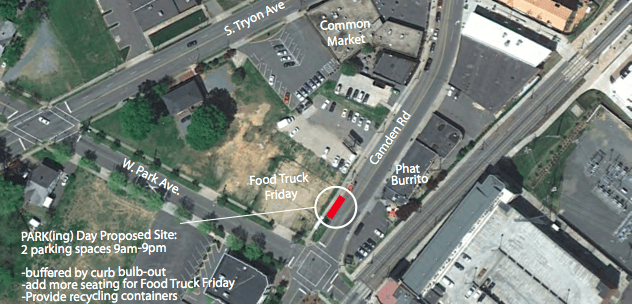Parking cars or PARK(ing) for people?

Who doesn’t prefer a park to asphalt or concrete? What would you rather see, a parking place, or a park? That’s the impulse at the heart of International PARK(ing) Day.
The yearly event has artists and other citizens transforming parking spaces – temporarily – into more people-friendly places. The event began in 2005 when workers at Rebar, a San Francisco art and design studio, turned a metered parking space into a park for two hours, which was the meter’s time limit.
Interest spread like wildfire to other cities, so Rebar launched PARK(ing) Day as an open-source global event. The parks pop up for one day only, the third Friday in September. This year it’s Sept. 21. By 2011 this movement of temporary parks created 975 parks in 162 countries. That’s up from 800 parks in 183 cities in 2010.
It’s time for Charlotte to have a role. I’d like people here to become more aware of how much space, both public and private, we give over to our cars. For instance, did you realize that more than 20 percent of the land area in uptown’s First Ward is given over to surface parking lots, not even counting decks or smaller residential lots? What about space for people? For one day, this effort reclaims just a fraction of parking spaces in Charlotte.
I’m organizing willing volunteers and donors to help get Charlotte on the PARK(ing) Day map. We are most in need of big potted plants and trees. Our goal is to borrow and reuse materials, so we don’t need to buy anything new or throw anything away. After all, we are operating on a $0 budget.
This year Wilmington has four parking spot transformations on the map; this is their third year participating. Spartanburg had six parks in its downtown last year. In 2010 Raleigh had its own interactive Bamboo Water Garden built by Georges Le Chevallier.
So far this year, other than Wilmington, our closest neighbors in PARK(ing) Day are Louisville and Chattanooga. Last year Louisville had seven parks. This year organizers have 26 pop-up parks already on the map. Chattanooga advertises that it will put pianos in its parks for people to play. To the north, Philadelphia has been participating for five years, and to celebrate, organizers have a 50-park goal this year, up from 33 last year.
Rebar offers guidelines in its Park(ing) Day Manual to think about:
- Ground cover (don’t use sod!)
- Seating
- Shade
- Enclosure
- Signage
- Spare change for the meters
The guidelines advocate for creating a noncommercialized space, with minimal signage.
Among the events and activities that have occupied a PARK(ing) Space in other cities: a wedding, a public back porch, a glass recycling center, a public kiddie pool, a national park, a free bicycle repair shop, a chess tournament, an art gallery, a pirates’ cove, a dinner party, a public reading room and a chicken coop.
And for Charlotte? Possibilities are endless. Mini-golf? A beach? A dance floor with a DJ? A dinner party?
I’m working with city officials* to help avert safety problems and make sure participants won’t get arrested (which has been rare in the history of this event). If you’d like to join me, contact me with an email.
Or launch your own PARK(ing) Day effort. I recommend talking to the City of Charlotte’s Department of Transportation if you aim to hit the streets, or else set up in a private lot. We certainly have enough of those around here. If you do, please let us know with an email to me or to PlanCharlotte, or a Twitter mention to @PlanCharlotte. And of course, share photos.
* Update: The city’s Department of Transportation has OK’d my plan to hold the event in South End on Camden Road at West Park Avenue, next to the “Food Truck Friday” lot.

Credit for Los Angeles photo: Nick Barkas.
Credit for San Francisco photo: SFCurbed.
Views expressed here are the author’s and not necessarily the views of the UNC Charlotte Urban Institute or the University of North Carolina at Charlotte.